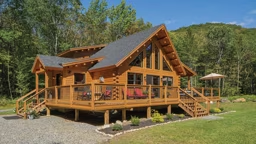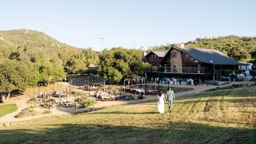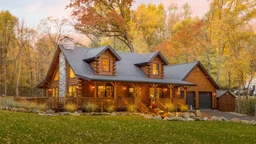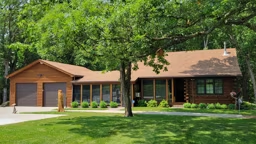Photos by Geoffrey Hodgdon
For Tom and Courtney Leigh, building a dream home presented an opportunity to put their beliefs into practice. Tom, who works as Riverkeeper for the Miles and Wye Rivers, as part of the Waterkeeper Alliance, and Courtney, an environmental education specialist, wanted a log home for their riverside site and began searching for the best option.
Katahdin’s sustainable forestry practices struck a chord with the couple. “It was something we wanted to support as a consumer,” Tom says.
The Leighs planned to build on family land that had been a certified tree farm; planted with hardwoods, softwoods and Christmas trees. They insisted on finding a builder who would respect their desire to save as many trees as possible.
After months of identifying trees that would remain on the site and those that would be transplanted, the Leighs were able to begin construction on their new home just 125 feet from the banks of the Wye River.

The now-completed home sets a stunning example for how to take advantage of beautiful views. The river and surrounding forest is just outside every room in the home, making the outdoors an integral part of the home’s ambiance. The home’s location drove other decisions, as well.
“We took advantage of the site’s natural configuration to filter water from the roof and driveways,” Tom says. A natural low point on their land became a rain garden.
Naturally hydrophilic (or water-loving) trees and other vegetation filters the runoff water before it returns to the river.

“The worst thing I could do as a waterkeeper,” Tom says, “is to be a hypocrite. I want to be a demonstrator. I have a responsibility and a duty to show people how they can make a positive contribution to their river.”
“One thing we believe in at Katahdin is that our green initiatives are not only good for our planet, but good for our company,” says David Gordon, Katahdin’s owner.
The company’s manufacturing process makes the most of a renewable resource by utilizing all parts of their locally sourced trees: Stripped bark is sent to a mulching company; small-diameter pieces are used as railings, fencing or other decorative items; and sawdust and wood scraps are burned as biomass to heat Katahdin’s mill buildings.











